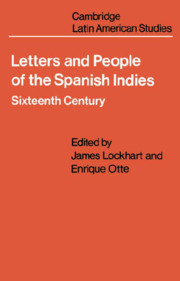Book contents
- Frontmatter
- Contents
- Preface
- Part I Conquest
- 1 Conquest in the personal view
- 2 A standard conqueror's report
- 3 The woman as conqueror
- 4 The merchant and the conquest of Peru
- 5 The merchant and the conquest of Mexico
- 6 The non-hero
- 7 The successful conqueror
- 8 The unsuccessful conqueror
- 9 The conqueror-governor
- 10 The conqueror in jail
- Part II The Variety of Life in the Indies
- Part III officials and Clerics
- Bibliography
- Index
1 - Conquest in the personal view
from Part I - Conquest
Published online by Cambridge University Press: 06 August 2018
- Frontmatter
- Contents
- Preface
- Part I Conquest
- 1 Conquest in the personal view
- 2 A standard conqueror's report
- 3 The woman as conqueror
- 4 The merchant and the conquest of Peru
- 5 The merchant and the conquest of Mexico
- 6 The non-hero
- 7 The successful conqueror
- 8 The unsuccessful conqueror
- 9 The conqueror-governor
- 10 The conqueror in jail
- Part II The Variety of Life in the Indies
- Part III officials and Clerics
- Bibliography
- Index
Summary
Gaspar de Marquina, in Cajamarca, Peru, to his father Martin de Garate in Mendaro, Biscay, 1533
… When he arrived where we were, the Governor rushed out with all his men and we attacked them and seized the lord and killed many of his people …
To match the hundreds of extant reports to the crown that governors and captains wrote about their conquests, there remain very few of the many letters the conquerors sent from the scene to family and friends. Most of these - and it is a characteristic worth noting - stick close to personal matters (the writer's fortunes, his prospects of coming home, his plans for relatives and for himself), hardly mentioning the progress of the conquest or the nature of the country. So the present letter is doubly rare, since the impressionable young man who wrote it did devote some space to the land of the Inca empire and the climactic event of the capture of its emperor, Atahuallpa, in which he took part. What he says is as fresh and direct as conversation, and with the complete honesty of a person who has no need to extol or excuse. Most accounts of the episode at Cajamarca give prominence to the dramatic parley in which a Dominican friar told Atahuallpa of Christianity and the Spanish king, with the fighting beginning only when the emperor broke off the talk. Gaspar skips over this as though it had never happened - not that it did not, but in his eyes it was an unimportant detail. What really happened was a great display of Indian wealth and numbers, followed by a sudden, total reversal when the Spaniards attacked. Gaspar bears the Indians no ill will and appreciates their accomplishments, indeed more than many other Spaniards of his time, but no need to justify the conquest ever occurs to him, nor is he concerned about the Indians' conversion (though he takes permanent Spanish government for granted).
An aspect that Gaspar lays bare more fully than do many reports by leaders, who enlarge on their own bravery and skill, or keep silent, is the overwhelming Spanish military superiority. When fighting nomads, the Spaniards faced military near-equals.
- Type
- Chapter
- Information
- Letters and People of the Spanish IndiesSixteenth Century, pp. 2 - 7Publisher: Cambridge University PressPrint publication year: 1976

